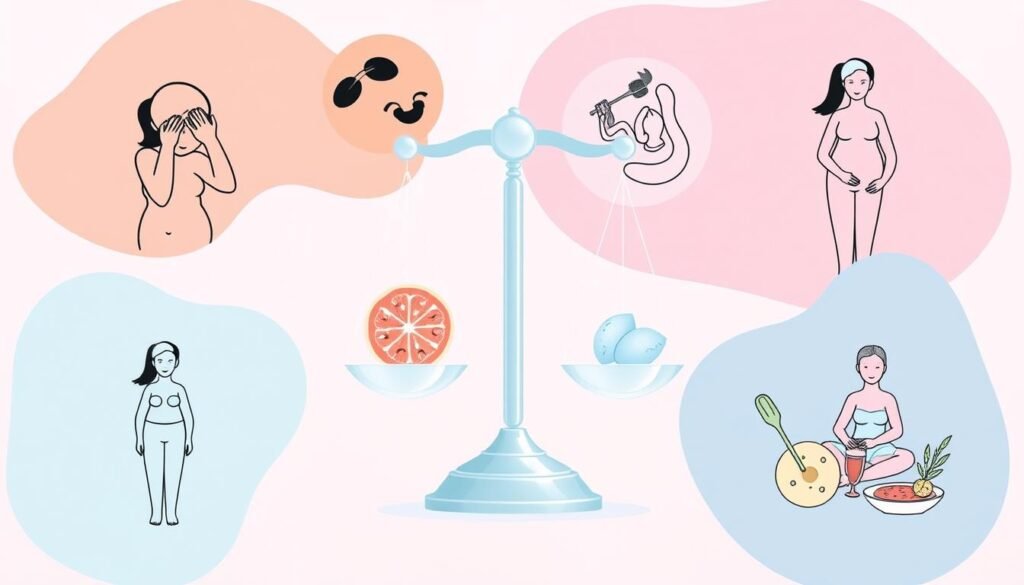About 1 in 10 women of childbearing age have Polycystic Ovary Syndrome (PCOS). It’s a top cause of infertility. This condition messes with hormone levels and makes conception tough for many. Ovulatory dysfunction includes various disorders that mess up regular ovulation, making getting pregnant hard. Knowing about these issues is key for those dealing with infertility. They affect hormone levels, periods, and reproductive health.
Women with irregular or no periods often face the hard emotional and physical sides of infertility. They need a thorough checkup and plan. Hormone problems can come from things like thyroid issues, how we live, and our genes. These can lead to issues with ovulation. Tracking ovulation and watching for symptoms are important for those seeking answers to their fertility problems.
Key Takeaways
- Ovulatory dysfunction can lead to irregular or absent menstrual cycles, affecting fertility.
- PCOS affects about 1 in 10 women, complicating hormone levels and getting pregnant.
- Thyroid disorders like hypothyroidism can negatively impact ovulation and fertility.
- Routine evaluations of both partners are essential, as around 40% of infertility cases involve male factors.
- Understanding one’s hormonal health is crucial for effective management of fertility issues.
- Early evaluation for infertility is advisable based on age and menstrual regularity.
- Both genetic and lifestyle factors can play a significant role in ovulatory dysfunction.
Understanding Ovulatory Dysfunction
Many couples struggle with fertility issues, often due to ovulatory dysfunction. Studies show 18 to 25 percent of these couples have ovulatory disorders. These problems can come from many places, like birth defects, hormonal imbalances, or changes in the endocrine system. This system is vital for releasing hormones that start ovulation.
Key concerns in ovulatory dysfunction include PCOS, hypogonadotropic hypogonadism, primary ovarian insufficiency, and hyperprolactinemia. Women with these conditions usually face oligomenorrhea, having periods every 35 days to six months. Spotting these patterns is key to understanding what’s wrong.
New classification systems from the International Federation of Gynecology and Obstetrics (FIGO) have improved our understanding. They’ve moved beyond the old WHO system. Now, they consider genetics, autoimmune issues, and other causes of failing to ovulate.
It’s key to understand not just for fertility, but overall health. Hormonal imbalances can affect bone, brain, sexual health, and more. Knowing about these issues is vital for diagnosing and managing fertility troubles linked to not ovulating.
| Key Ovulatory Disorders | Characteristics |
|---|---|
| Polycystic Ovary Syndrome (PCOS) | Common cause of ovulatory dysfunction, often leading to irregular menstruation. |
| Hypogonadotropic Hypogonadism | Impaired secretion of hormones needed for ovulation. |
| Primary Ovarian Insufficiency | Early loss of ovarian function before age 40. |
| Hyperprolactinemia | Elevated levels of prolactin affecting menstrual cycles. |
Common Symptoms of Ovulatory Dysfunction
Ovulatory dysfunction can really affect reproductive health. Many experience irregular periods, with changes in flow or missed cycles, known as amenorrhea. About 30% of those assigned female at birth face abnormal bleeding due to anovulation.
Hormone imbalances can upset many body functions. Conditions like polycystic ovary syndrome (PCOS) are often to blame, causing 70% of anovulation cases. PCOS can lead to acne, unwanted hair growth, and weight changes. These signs are key in spotting potential fertility issues.
- Irregular menstrual cycles
- Prolonged or absent menstruation
- Prolonged cycles and abnormal uterine bleeding
- Symptoms related to hormone dysregulation, such as acne
- Weight changes
Knowing these symptoms of ovulatory dysfunction helps in getting the right help on time. Treatment options, including lifestyle changes and medicines, can improve these conditions. More info on treatments is available here.
Types of Ovulatory Dysfunction
Understanding the types of ovulatory dysfunction is key to diagnosing and treating infertility. These dysfunctions have various underlying causes. Polycystic Ovary Syndrome (PCOS) is the main cause of female infertility, causing about 70% of anovulation cases.
Premature ovarian failure significantly affects young women under 40. It leads to less estrogen production and possibly early menopause. This disorder disrupts normal ovulation.
Hyperprolactinemia means having too much prolactin, which affects ovulation. It’s important to recognize this to tackle infertility issues. The right hormonal balance is crucial for ovulation.
Thyroid dysfunction is another critical issue. Thyroid hormones help control the body’s metabolism. If they’re off, it can mess with ovulation. This often results in irregular or no menstrual periods.
It’s important to know about the different ovulatory dysfunctions. For more info on ovulation induction, understanding these disorders is helpful. It allows for better treatment plans.
The Role of Hormones in Ovulation
It’s key to understand the hormones in ovulation to know how the body releases an egg. Follicle-Stimulating Hormone (FSH), Luteinizing Hormone (LH), and Gonadotropin-Releasing Hormone (GnRH) are crucial. They ensure the ovary works right. FSH helps ovaries make follicles, and LH gets an egg released.
GnRH from the hypothalamus makes the pituitary gland produce FSH and LH. This hormonal regulation keeps the menstrual cycle regular. On average, an ovulation cycle loses about 1,000 follicles. The body picks a main follicle to release. Over time, fewer follicles remain, leading to menopause and the end of ovulation.
Hormonal balances can affect ovulation. Issues like polycystic ovarian syndrome (PCOS) can mess with FSH and LH. This makes ovulation irregular. Hormonal imbalances can cause problems for those trying to get pregnant.
The following table shows different anovulation types as the World Health Organization explains. These are based on hormonal problems:
| WHO Class | Description |
|---|---|
| 1 | Hypogonadotropic hypogonadism |
| 2 | Normogonadotropic hypogonadism |
| 3 | Hypergonadotropic hypogonadism |
| 4 | Hyperprolactinemia |
Hormones must work together for a woman’s reproductive health. Balancing these hormones can help with regular ovulation. This supports fertility and wellbeing.

The Impact of Ovulatory Dysfunction on Conception
Ovulatory dysfunction can greatly affect a woman’s chance to have a baby. It includes conditions like not ovulating regularly or not at all, each posing different problems.
Infrequent Ovulation and its Effects
When a woman does not ovulate often, it’s hard to get pregnant. This condition means fewer opportunities for an egg to be fertilized. PCOS is a key cause, leading to hormonal imbalance and ovulation issues. Women with this problem may need help from doctors to conceive.
Anovulation: The Absence of Egg Release
Anovulation means no eggs are released, making pregnancy much harder. It causes unpredictable periods, making it tough to know the best time to try for a baby. The World Health Organization says about 25% of infertility issues are due to these ovulation problems. It shows how crucial it is to treat both rare and absent ovulation when trying to conceive.
| Condition | Description | Impact on Conception |
|---|---|---|
| Infrequent Ovulation | Irregular release of eggs | Reduces chances of fertilization |
| Anovulation | No egg release at all | Eliminates opportunity for conception |
Risk Factors Associated with Ovulatory Dysfunction
Understanding the risk factors for ovulatory dysfunction is essential. Many elements, like genetics, hormonal imbalances, and lifestyle choices play a role. Knowing these can help women take control of their reproductive health.
Genetic and Hormonal Influences
Genetics is a key factor in ovulatory dysfunction. For example, polycystic ovary syndrome (PCOS) affects about 6.5% of women of childbearing age. An overwhelming majority of women with PCOS experience ovulatory issues. A family history of ovarian problems can increase hormonal imbalance risks.
Conditions like hyperandrogenism and insulin resistance often accompany PCOS. They can mess with the hormones that control ovulation.
Lifestyle Factors Affecting Ovulation
How you live can affect ovulation. High stress, obesity, and very low body weights have been linked to ovulation problems. Smoking can make these issues worse. For instance, more women with PCOS who have ovulation issues smoke compared to those without these problems.
Eating a lot of meat might also affect ovulation, especially in women with PCOS. Environmental factors like air fresheners and cooking oil fumes may harm ovarian functions. Combining unhealthy lifestyle choices with genetic risks makes maintaining ovulatory health complex.

Conditions Contributing to Ovulatory Dysfunction
Several medical conditions causing ovulatory dysfunction can greatly affect a woman’s ability to get pregnant. Endometriosis is one such condition where uterine tissue grows outside the uterus. This can mess up hormone levels and make ovulation hard.
Ovarian cysts are common too. They can mess with the growth of follicles or cause pain. This often leads to irregular periods and makes getting pregnant harder.
Thyroid disorders are important to fertility as well. Imbalanced thyroid levels can make periods irregular. This makes ovulation unpredictable and affects a woman’s reproductive health overall.
Knowing about these conditions can help in finding the right treatment. Here’s a summary of common issues with ovulation:
| Condition | Description | Impact on Ovulation |
|---|---|---|
| Endometriosis | Presence of endometrial-like tissue outside the uterus. | Can create hormonal imbalances, making ovulation irregular. |
| Ovarian Cysts | Fluid-filled sacs on the ovaries. | May disrupt follicle development and cause pain. |
| Thyroid Disorders | Conditions affecting thyroid hormone production. | Can lead to uneven menstrual cycles and ovulation issues. |
| Polycystic Ovarian Syndrome (PCOS) | A hormonal disorder affecting ovaries. | Commonly results in irregular or absent ovulation. |
| Hyperprolactinemia | High levels of prolactin hormone. | Can lead to irregular or missing ovulation. |
| Hypothalamic Amenorrhea | Disruption due to hypothalamus gland issues. | Can result in absent menstruation and ovulation. |
Proper medical help can greatly increase fertility for those struggling with ovulatory dysfunction.
Diagnosing Ovulatory Dysfunction
To figure out ovulatory issues, experts start with a detailed medical history. This helps them understand the patient’s menstrual cycles and past health problems that could affect fertility. Knowing the patient’s medical history sets the stage for deeper checks, like looking for signs of irregular ovulation.
Medical History and Symptoms
Doctors look at the regularity, length, and frequency of menstrual cycles. Irregular or missing periods might suggest ovulation problems. Severe weight changes, too much hair growth, and acne are signs too, especially with PCOS. Spotting these signs is important for diagnosing ovulatory dysfunction.
Laboratory Testing Procedures
After gathering a patient’s medical history and checking symptoms, lab tests are key. They check hormone levels like FSH, LH, and prolactin. These tests confirm the diagnosis and check for other issues like hypothyroidism and hyperprolactinemia. Tests on serum progesterone and imaging help see the full picture of reproductive health.

Treatment Options for Ovulatory Dysfunction
Treating ovulatory dysfunction involves different methods. These methods help restore normal ovulation and boost fertility. It’s important for people trying to conceive to know their options.
Medications Used for Inducing Ovulation
Ovulation induction medicines are key in treatment for ovulatory dysfunction. Some commonly used medications are:
- Clomiphene Citrate: This is often the first option. It works by stimulating the ovaries to promote egg growth.
- Letrozole: A substitute for Clomiphene, it helps with ovulation by lowering estrogen levels.
- Gonadotropins: These are hormones given through injections. They directly stimulate the ovaries and are effective for many women. However, they come with a higher chance of multiple pregnancies.
- Metformin: Mainly for women with insulin issues, it can make ovulation better.
- Bromocriptine: It’s used for treating conditions that can stop ovulation, like high prolactin levels.
Injectable fertility drugs have a 30% chance of twins or more. Oral drugs are safer, with under a 10% chance of multiples.
Lifestyle Changes as Treatment
Making lifestyle changes for fertility can also better your hormonal balance and reproductive health. Some good changes are:
- Balanced Diet: Eat a variety of foods rich in vitamins and minerals for better health.
- Regular Exercise: Stay active to keep a healthy weight.
- Stress Management: Use yoga, meditation, or therapy to lower stress. This is good for your fertility.
- Avoiding Tobacco and Excessive Alcohol: Cutting back on these can boost your reproductive health.
Using medicines and making healthy lifestyle changes can be a full approach to handle ovulatory dysfunction. Many couples see their chances of having a baby go up with help from fertility experts.
| Treatment Method | Type | Risk of Multiple Pregnancies | Additional Notes |
|---|---|---|---|
| Clomiphene Citrate | Oral | Less than 10% | First-line treatment option. |
| Letrozole | Oral | Less than 10% | Useful for women with PCOS. |
| Gonadotropins | Injected | Up to 30% | Higher risk of multiple births. |
| Metformin | Oral | N/A | Helps those with insulin resistance. |
| Bromocriptine | Oral | N/A | Treats hyperprolactinemia. |
Infertility Treatments Related to Ovulatory Dysfunction
Women facing ovulatory dysfunction often turn to advanced infertility treatments to help them conceive. These treatments aim at correcting the hormone imbalances that prevent normal ovulation. In Vitro Fertilization (IVF) and donor IVF are among the top methods for this condition. Both offer unique benefits for various personal situations.
In Vitro Fertilization (IVF) Options
IVF is a highly sought-after method for those with ovulatory issues. It stimulates the ovaries to produce multiple eggs. These eggs are then collected and fertilized in a lab. After fertilization, the embryos are placed into the uterus to increase pregnancy chances. IVF can be tailored to meet the specific needs of couples facing ovulatory-related infertility.
Donor In Vitro Fertilization
Donor IVF is a hope for women who can’t use their own eggs due to conditions like premature ovarian failure. It involves using a donor’s eggs, which are fertilized and implanted into the recipient’s uterus. This method is especially helpful for people dealing with serious ovulatory issues since it skirts the problem of egg production. Both IVF and donor IVF have helped many couples achieve the dream of parenthood.
| Type of Treatment | Description | Ideal For |
|---|---|---|
| IVF Options | Stimulating multiple egg development, followed by lab fertilization and embryo implantation. | Women with ovulatory dysfunction able to produce eggs. |
| Donor IVF | Using donor eggs for fertilization and implantation into the intended mother’s uterus. | Women with absent or low egg quality due to severe ovulatory dysfunction. |
Conclusion
Ovulatory dysfunction is a big problem for women who want to have a baby. It affects their fertility. Knowing the symptoms, risk factors, and how to treat them is key. Ovulation disorders are a top reason for infertility, says the World Health Organization. Getting the right diagnosis and treatment early can really help women’s chances of conceiving.
There are many kinds of ovulatory disorders, like polycystic ovary syndrome and endometriosis. Understanding these is vital for getting the right treatment. Women can manage their reproductive health by learning about fertility. PCOS, for instance, affects many women. It can lead to more problems during pregnancy. This shows why expert care is critical.
Choosing the right healthcare options leads to better health outcomes. The ongoing search for effective treatments shows dedication to those dealing with ovulatory dysfunction. For more info and advice, you can read the detailed study here.